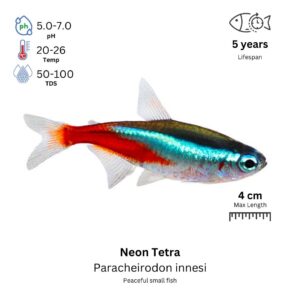Characteristics
The Blue Axelrod’s Rasbora, scientifically known as Sundadanio axelrodi, is a captivating nano fish species prized by aquarium enthusiasts. Native to Southeast Asia, this species is known for its vibrant coloration and peaceful demeanor. It thrives in soft, slightly acidic water and prefers densely planted aquariums.
- Natural Habitat: Slow-moving streams and peat swamps with dense vegetation.
- Behavior: Active and peaceful, best kept in schools.
- Tank Preferences: Small tanks with plenty of hiding spots and subdued lighting.
- Ideal Water Parameters:
- pH: 5.0–7.0
- Hardness: Soft to moderately hard
- Temperature: 22–28°C (72–82°F)
- Care Difficulty: Moderate due to sensitivity to water quality.
Origin and Distribution
Blue Axelrod’s Rasbora is endemic to the blackwater streams and swampy regions of Borneo and Sumatra in Indonesia. These areas are rich in tannins from decomposing leaf litter, creating the tea-colored water they prefer. Their natural habitat is characterized by low mineral content and acidic conditions, making them unique among freshwater fish.
Colors and Markings
This rasbora’s standout feature is its shimmering blue body, complemented by a silvery belly. The males tend to display more vibrant colors, especially when courting, with a metallic sheen that appears under the right lighting. Their fins are semi-transparent, with subtle hints of red or orange at the edges.
Tankmates
As peaceful schooling fish, Blue Axelrod’s Rasboras thrive in community tanks with similarly sized, non-aggressive species. Ideal tankmates include:
- Other small rasboras (e.g., Harlequin Rasbora)
- Tetras (e.g., Neon or Ember Tetras)
- Small gouramis
- Shrimp and snails
Avoid pairing them with larger or aggressive fish that may outcompete or prey on them.
Care Requirements
To ensure optimal health:
- Tank Size: A minimum of 10 gallons for a small school of 6–8 fish.
- Water Quality: Maintain pristine water conditions with regular water changes.
- Lighting: Subdued lighting to mimic their natural habitat.
- Aquascape: Dense planting with driftwood and leaf litter for hiding spots and tannin-rich water.
Diet and Feeding
Blue Axelrod’s Rasbora is an omnivore. In the wild, they feed on micro-crustaceans, insects, and plant matter. In captivity, they enjoy:
- High-quality micro-pellets
- Live or frozen foods (e.g., daphnia, brine shrimp)
- Occasional blanched vegetables (e.g., zucchini, spinach)
Feed small amounts 2–3 times daily to match their tiny stomachs.
Gender Differences
Males and females can be distinguished by:
- Males: Brighter coloration and a slimmer body.
- Females: Rounder bodies, especially when gravid.
Breeding
Breeding Blue Axelrod’s Rasbora in captivity can be challenging but rewarding:
- Setup: A separate breeding tank with fine-leaved plants or spawning mops.
- Water Parameters: Slightly acidic, soft water with a temperature around 26°C (79°F).
- Spawning Behavior: Females scatter eggs, which males fertilize externally.
- Post-Spawning: Remove adults to prevent them from eating the eggs.
The eggs hatch within 24–36 hours, and fry become free-swimming within 4–5 days. Feed infusoria or finely crushed flake food.
Additional Resources
For more insights into nano fish care and aquascaping:
- Books: “Nano Aquarium Ideas” by Chris Andrews
- Websites: Aquascaping blogs and forums like The Planted Tank
- Videos: YouTube tutorials on breeding and setting up blackwater tanks
Blue Axelrod’s Rasbora is an enchanting addition to any nano aquarium, offering beauty and grace in a small package. With proper care, these tiny gems can thrive and bring joy to hobbyists for years.



Reviews
There are no reviews yet.